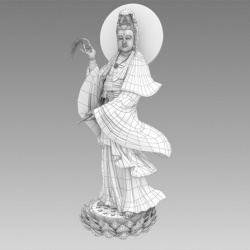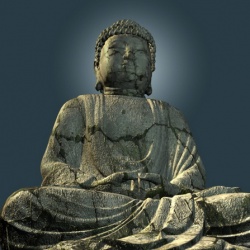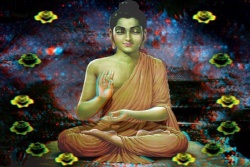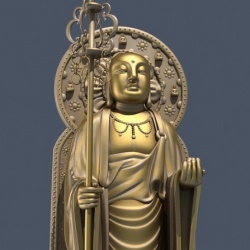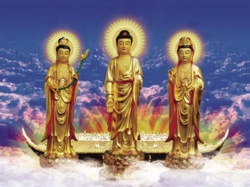Prasaṅgika
The Prasangika (Skt. Prāsaṅgika; Tib. ཐལ་འགྱུར་པ་, Wyl. thal 'gyur) or 'Consequence' tradition is a subdivision of the Madhyamika school of philosophy.
A defining feature of this approach is its use of consequentialist arguments (Skt. prasaṅga) to establish the ultimate truth of emptiness beyond all conceptual elaboration.
This approach was first explicitly formulated by the Indian scholar Buddhapalita and later elaborated upon and defended by Chandrakirti.
Definition
In the Nyingma tradition of Mipham Rinpoche the Prasangika are defined as "followers of the Madhyamika who teach by emphasizing the uncategorized absolute that is free from all assertions".[1]
Notes
Further Reading
- The Svatantrika-Prasangika Distinction—what difference does a difference make?, edited by Georges B.J. Dreyfus and Sara L. McClintock (Boston: Wisdom Publications, 2005).
Internal Links
"Prasaṅgika Emptiness" is the theory that all things and phenomena lack (or are empty of) any type of inherent identity or self-characterizing essence.
This lack of inherent existence does not mean that all phenomena are non-existent; inherent non-existence is also negated by Prasaṅgika emptiness.
In the philosophy of Mahayana Buddhism, specifically in the Madhyamaka view, Prasaṅgika Emptiness is a category of Madhyamaka viewpoints attributed primarily to Indian scholar Candrakirti,
but which is based also on Buddhapalita's commentaries on Nagarjuna. Nagarjuna and later commentators use the method of logical consequence (prasanga in Sanskrit) to refute flawed views.
By using this type of reductio ad absurdum, Nagarjuna, Buddhapalita, Candrakirti, and later Lama Tsongkhapa simultaneously refutes incorrect/opposing viewpoints and establishes the position of Prasaṅgika.
"Emptiness," in the Prasaṅgika sense, does not mean space, lack of physical obstruction, non-existence, or the simple not-finding of a conventional identity for the object or phenomenon being scrutinized.
Prasaṅgika is the conclusive analytic absence of any findable internal quality of an object or phenomenon which provides a name, identity, function, and/or discreteness to that object or phenomenon.
The strong implication being that the mind of the observer (technically, a conceptually designating consciousness) provides the name, identity, function, and conventional discreteness to that object.
The relationship between the mind and object is commonly described as "Co-dependent arising, dependent arising, and dependent origination."
The mind is also viewed as dependently arising on the basis of the object which that mind knows.
This is why, when one analyzes a material object, a mind, or an abstract phenomena (like time, non-composed space, coming, going, causality, etc) that nothing self-characterizing or identity providing is found.
History
The Madhyamaka views generally were expounded as commentaries upon the work of Nagarjuna, who wrote about the Prajnaparamita sutras.
Buddhapalita was an early adopter of syllogistic methods in his teachings, although of a particularly limited form.
He commented upon Nagarjuna using logical consequences.
Bhavaviveka later commented upon and critiqued Buddhapalita's interpretation of Nagarjuna.
Candrakirti later responded to Bhavaviveka's criticisms. His response became identified as exemplary of the Prasangika approach and view.
When Buddhism was established in Tibet, however, the primary philosophic viewpoint established there was that of Shantarakshita – a synthesis of Yogacara and Madhyamaka – in the 9th century.
Much later Je Tsongkhapa established Candrakirti's work as primary and it continues as the main approach to Madhyamaka in the Gelug school.
Other masters of the various lineages of Tibetan Buddhism also contemplate Prasaṅgika views but hold different opinions with regards to the best way to describe the experience of emptiness (i.e. Prasaṅgika, Svatantrika, Chittamatra, and their sub-schools).
Svatantrika debate
Bhavaviveka was later categorized - most prominently by Lama Tsongkhapa - as presenting a Svatantrika view , in opposition to Candrakirti's Prasaṅgika.
While this was a later distinction, it was useful for students to study the viewpoints as a set of tenets and subsequent metaphysical consequences that could be debated and discussed.
This usage is sometimes referred to as the "Prasaṅgika school" and the "Svatantrika school", even though no schools with those names existed.
Some masters of the Gelug argue that Je Tsongkhapa's description of the views various schools of emptiness are meant to be a {{Wiki|psychologically]] reflexive tool for identifying when we are falling into those schools of thought during our ordinary activities, and that they are not meant to be a historical doxography.
Ordinary activity here refers to the ethical choices we make under the influence of the understanding of emptiness, during our path practice as a Bodhisattva. (See Paths and Grounds of a Bodhisattva)
The Prasaṅgika-Svatantrika distinction included both a technical component and a set of metaphysical implications. On one level, the disagreement centered around the role of prasanga in formal debate.
While the Prasangika view holds it to be the only valid method of demonstrating emptiness of inherent existence, the Svatantrika felt that assertions about the nature of the ultimate were also necessary.
The Prasaṅgika counter that when attempting to find the correct object of understanding - which is a mere absence or mere negation of impossible modes of existence - one should not use positivist statements about the nature of reality.
Positing an essencelessness rather than merely negating inherent identity creates a subtle linguistic and analytic barrier to finding the correct understanding.
In the Lam Rim Chen Mo, Je Tsongkhapa writes extensively on the Prasaṅgika/Svātantrika distinction and also addresses several contemporary analyses, several of which are shown by Elizabeth Napper to be pertinent to modern scholarship.
Tsongkhapa's thesis is that after a very lengthy and well-referenced debate, strongly relying upon Candrakirti's (a Prasaṅgika) analysis of Bhāvaviveka (a Svātantrika) in the Prassana-padā
The opponents of Candrakirti's Prassana-padā (a seminal text regarding the Prasaṅgika/Svātantrika distinction) are both (a) the essentialists, who accept that things ultimately have intrinsic nature, and (b) the Svātantrikas, who refute that, but accept that things conventionally have intrinsic character or intrinsic nature.
However, from Ju Mipham's view, Tsongkhapa himself is considered to be a Svatantrika. Blankleder/Fletcher write:
The Gelugpa interpretation of Prasangika has often been described by its critics as a form of Svatantrika in disguise, since its presentation of "conventional,"
as distinct from "true," existence seems very close to the "existence according to characteristics" that Bhavya had ascribed to phenomena on the relative level.
This position is, however, also refuted conclusively in Lama Tsongkhapa's "Ocean of Reasoning."
The Svatantrika posit that a unique, conventionally existing identity arises on the part of each individual phenomenon which makes that phenomenon a natural basis for the designation of a particular term or identity.
The Prasaṅgika reject this idea given that, even if such an natural identity were findable with analysis (which it is not) such an identity cannot account for the various properties of identity and fails in a very similar way to inherent identity to provide an explanatory picture for our normal everyday experience.
For example, since a specific table has a unique conventionally arising characteristic of 'being that unique and specific object,' that unique characteristic does not provide the object with the natural identity of being "Table."
That unique characteristic does not have an element to its natural identity which allows it to belong to the general class of objects. Since this is the case, it does not provide that object with a table identity or make it a natural base to be a table.
This and many other arguments by the Prasaṅgika show that there are legitimate ontological differences between the two schools of thought and that they are not really one school of thought that has a division in terms of how they describe the conventional and empty natures of phenomena.
Logical Consequence & Negation
A prominent and important feature of the Prasaṅgika approach is their use of the non-affirming negation.
A non-affirming negation is a negation which does not leave something in the place of what has been negated.
For instance, when one says that a Buddhist should not drink alcohol, they are not affirming that a Buddhist should, in fact, drink something else.
We are merely negating the consumption of alcohol under a particular circumstance and not affirming the consumption of anything else.
The Prasaṅgika argue that emptiness (lack of inherent existence, the nature of all existent phenomenon) is itself a non-affirming negation.
Emptiness a mere absence of impossible modes of existence.
So, if one were to describe emptiness as the presence of some quality (essencelessness, selflessness, tao, the ultimate nature which exists 'out there somewhere,' etc) it linguistically contradicts the nature of the object.
Emptiness is the simple absence of inherent existence, true existence, occult entities, inherent identities, etc as having any role in the arising or existence of any object or phenomenon.
It is not the presence of some other quality which is being affirmed in the place of the absence of those modes of existence.
The criticism of this approach by other schools of thought within Buddhism, and much later by Western scholars, is that it slides into Nihilism.
Since we have negated the inherent identity of object, but we have not affirmed anything else, haven't we negated the object's existence completely?
Lama Tsongkhapa's argues that we have not negated the object completely, but rather have merely eliminated an impossible mode of existence misattributed to the object
(see Ignorance.
By negating inherent existence, we have negated a mode of existence which would have made the valid conventional arising and existence of the object impossible.
Therefore, we have provided argumentation in favor of the conventional arising and existence of the object.
An affirming negation is the opposite.
When you negate that someone is a Senator in a situation where you know they must be either a Senator or a Representative, then you have affirmed they are a Repesentative.
This is a very important point which gets at the heart of a number of issues, particularly in the Prasaṅgika-Svatantrika debate.
The Svatantrika are primarily using syllogistic reasoning to arrive at emptiness.
While this approach is also effective, it leaves room to affirm that there is a "real, true, and inherent essenceless or emptiness out there" which has major philosophical problems from the Prasaṅgika point of view. Nagarjuna's Merely Designated Causality
In Nagarjuna's own words, causality itself is not findable as existing inherently.
"Neither from itself, nor from other,
Nor from both,
Nor without a cause
Does anything anywhere, ever arise."
The implied modifying phrase in this passage according to Lama Tsongkhapa is "inherent."
So, the negations in this passage would read:
Not from inherent self,
not from inherent other,
not from inherent both,
not from inherent nothingness/causelessness.
Notice that each one of these statements is a non-affirming negation which merely negates the subject (some type of inherent cause for the arising of any given conventional phenomenon) and does not affirm some other mode of arising in its place.
These four possibilities include all possible ways that a conventional phenomenon could arise if, in fact, they arose through some type of inherent arising process.
Each one of these modes is negated in sequence (from self, from other, from both, from no cause) leaving you with a mere absence: the absence of inherent modes of causality.
All these arguments are flushed out individually in Lama Tsongkhapa's commentary to Nagarjuna "Ocean of Reasoning."
The causality of the Prasaṅgika is one of mere designation.
For example, in a flow chart of the process of a seed turning into a sprout: if we selected 5000 photographs of all the intermittent stages from seed to sprout and independently asked 50 people,
"Where does the seed become the sprout?" There would probably be 50 different answers.
Nagarjuna's argument according to Lama Tsongkhapa is that if the sprout arose (came into existence) inherently in any of the four ways listed above, then all 50 people would independently have no choice but to say, "Yes, on slide 2199 the sprout arose.
That is clearly and definitely the case."
On the other hand, since the arising of a sprout is something which is merely nominally designated by the conceptual mind, when we independently question 50 people, we get 50 different answers.
This is a strong indication that the sprout and all other objects are not something which arise and exist objectively or inherently.
It indicates that human beings do not passively experience phenomena, but that the content of our experiences is something which is validly conceptually designated by mind.
The mind aspect of reality provides the name, identity, function, and conventional discreteness to phenomena, according to the Prasangkia.
In the flowchart example, the moment mind validly decides that the object "seed" is no longer a valid basis for the term and concept "seed," it labels the term-concept "sprout" and that object becomes a sprout.
When mind validly applies the term and concept "sprout" to its experience, that experience becomes a sprout.
The arising of the sprout is causally linked to the valid designation of the term-concept "sprout," and not some causal force that existed previously in the seed, nor some identity of sproutness that existed somewhere prior to the arising of the sprout.
Designation is - in the basic Buddhist sense - the application of a conceptual (or in some cases non-conceptual) image and a term to a selected object of experience.
Once the object is validly designated as a sprout, that object of experience exists as a sprout (for more information see also 7-point analysis of a chariot).
It is important to note that there are also invalid ways to designate objects, which will be talked about in the next section.
The rules for valid vs invalid designation are clearly laid out.
Lam Rim Chen Mo A Prasaṅgika asserts that something exists conventionally (synonym:
validly designated) if it meets all of the following three conditions:
if it is known to a conventional consciousness
if no other conventional cognition contradicts its being as it is thus known
if reason that accurately analyses reality (that is, analyses whether something intrinsically exists) does not contradict it
Whatever fails to meet those criteria does not exist.[18] Therefore Prasaṅgikas cannot accept that intrinsic nature exists, even conventionally.
Indo-Tibetan Rope Snake: Valid & Invalid Designation
When most people hear that all phenomenon only arise because they are designated by a mind, they skeptically ask, "Well, if that is the case, then can't anything be anything? Can't a table be a wall and a rabbit be an elephant?"
According to Lama Tsongkhapa, the answer to all of those questions is no.
There is an example which makes valid and invalid conceptual designation easy to understand.
This is the Rope-Snake example:
A coiled rope's speckled color and coiling are similar to those of a snake,
and when the rope is perceived in a dim area, the thought arises, “This is a snake.”
As for the rope, at that time when it is seen to be a snake,
the collection and parts of the rope are not even in the slightest way a snake.
Therefore, that snake is merely set up by conceptuality.
This example is more often used when trying to help Buddhist philosophers and practitioners find the absence of inherent "I, me," but it is also helpful in the discussion of valid and invalid designation.
If we refer back to Lama Tsongkhapa's guidelines, this rope cannot be validly designated a snake for several reasons.
First off, at a later period of time and under different conditions, you will not designate that object as a snake, you will validly designate it as a rope based upon the socially agreed upon use of the term-concept rope.
Therefore, a subsequent conventional consciousness in the same continuum of mind contradicts the object being currently known as a snake.
Also, the object cannot fulfill the conventionally agreed upon function of a snake, so it violates the rule that the term-concept designated must stay within the agreed upon use of the term-concept.
Since this is the case, according to the social arena in which the term "rope" means one thing and "snake" means something else, the use of the term-concept to designate and describe that experience is invalid.
As a side note, in the same way that there is nothing inherent to that object that is providing the snake identity, there is nothing inherent to that object which is providing a "rope" identity.
The rope identity is something which is validly imputed later by a designating consciousness.
Even after the rope is conceptually designated as a rope, there is no rope identity happening among the material parts of that object.
From the side of the object, it is absent any inherent quality or conventional quality which forces us to label and experience that mere phenomena as a rope.
This is consequently why it is possible to misattribute the identity of a snake to a rope in the first place.
This is also the reason the term-concept rope can be validly applied to a unique object of experience and cause that object (when there are no qualities which would socially or ultimately disqualify that object from being a rope) to exist and function as a rope conventionally.
This discussion may also provide evidence for the case that Prasangika and Svatantrika have huge differences.
There is a difference between the mere absence of inherence and valid conventional existence according to the Prasangika, and the absence of true existence and existence according to characteristics of the Svatantrika. </poem>
